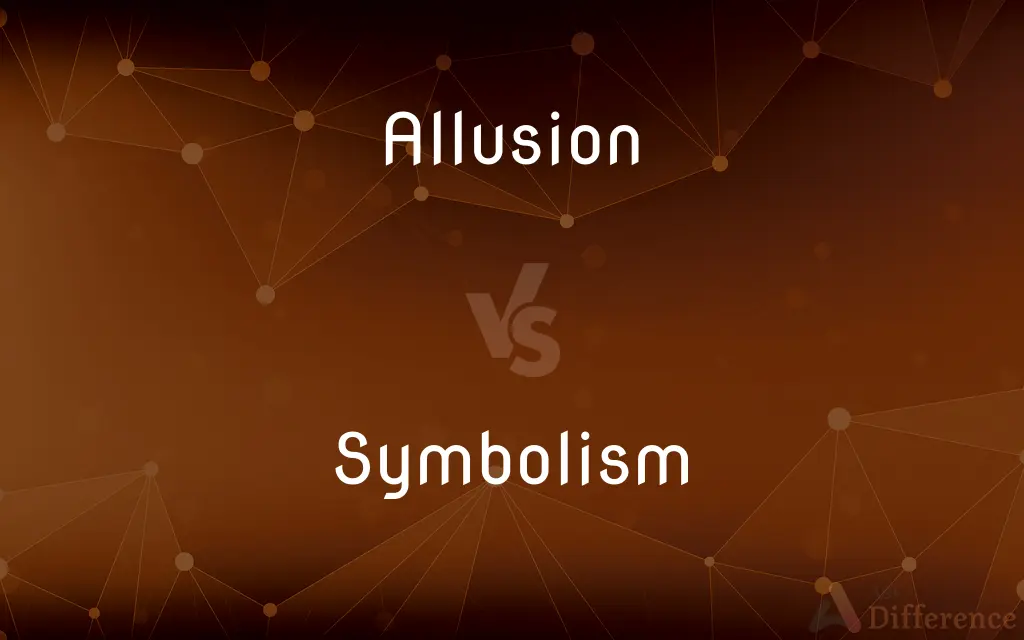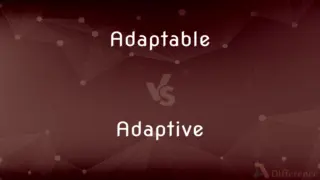Allusion vs. Symbolism — What's the Difference?
Edited by Tayyaba Rehman — By Fiza Rafique — Updated on May 3, 2024
Allusion refers to indirect references within a text to external concepts or works, enhancing depth, while symbolism uses objects or elements to represent broader themes or ideas.

Difference Between Allusion and Symbolism
Table of Contents
ADVERTISEMENT
Key Differences
Allusion involves the mention or suggestion of an external piece of work, historical figure, or event within another work, which enriches the reader’s understanding and connects the text to broader cultural or historical contexts. On the other hand, symbolism employs specific objects, figures, or actions within a text to embody abstract qualities or deeper meanings beyond their literal sense.
While allusion relies on the reader's familiarity with the referenced work or concept to add layers to the narrative, symbolism uses the inherent elements of the work itself to suggest ideas and reflect themes.
Allusions can be fleeting and specific, while symbols are often recurrent and crafted to invoke multiple layers of interpretation.
Allusions are primarily a literary device to build a richer context, drawing from existing works or real-world references. In contrast, symbolism can be found across various art forms, creating universal meanings that are open to interpretation based on the viewer's or reader's perspectives.
Comparison Chart
Definition
A reference in a text to another text or context
Use of objects or actions to represent ideas
ADVERTISEMENT
Function
To enrich text by reference to other works
To imbue narrative with deeper meanings
Dependence
Relies on existing knowledge
Relies on intrinsic narrative elements
Frequency of Use
Can be singular or multiple, often subtle
Often repetitive and integral to understanding
Examples in Usage
"He was a real Romeo with the ladies."
The use of a rose to symbolize love in poetry
Compare with Definitions
Allusion
A literary device that references another work or famous figure indirectly.
Her garden was a Garden of Eden.
Symbolism
Objects or actions that convey deeper, often moral or philosophical, meanings.
The fog in the story symbolizes confusion and danger.
Allusion
A subtle nod to another piece of literature, art, or history.
He has the patience of Job.
Symbolism
A technique using symbols to signify ideas and qualities.
Doves are used to symbolize peace in literature.
Allusion
Often used to connect contemporary work with classical themes.
This place is like a Band-Aid on a bullet wound.
Symbolism
Central to thematic development in literature and art.
The green light in The Great Gatsby symbolizes Gatsby’s hope and dreams.
Allusion
Requires reader's recognition to fully appreciate the reference.
That little company is a David in a world of Goliaths.
Symbolism
Can be cultural, religious, or purely artistic in nature.
Water in many cultures symbolizes purification and life.
Allusion
Enhances the depth of the narrative through indirect connections.
It was his Waterloo.
Symbolism
Symbols often operate on multiple levels of meaning.
The chain in Marlowe’s play symbolizes both bondage and the unbreakable nature of fate.
Allusion
Allusion is a figure of speech, in which an object or circumstance from unrelated context is referred to covertly or indirectly. It is left to the audience to make the direct connection.
Symbolism
The practice of representing things by means of symbols or of attributing symbolic meanings or significance to objects, events, or relationships.
Allusion
An expression designed to call something to mind without mentioning it explicitly; an indirect or passing reference
A classical allusion
An allusion to Shakespeare
Symbolism
A system of symbols or representations.
Allusion
The act of alluding; indirect reference
Without naming names, the candidate criticized the national leaders by allusion.
Symbolism
A symbolic meaning or representation.
Allusion
An instance of indirect reference
An allusion to classical mythology in a poem.
Symbolism
Revelation or suggestion of intangible conditions or truths by artistic invention.
Allusion
An indirect reference; a hint; a reference to something supposed to be known, but not explicitly mentioned
Symbolism
Symbolism The movement, theory, or practice of the late 19th-century Symbolists.
Allusion
A figurative or symbolical reference.
Symbolism
Representation of a concept through symbols or underlying meanings of objects or qualities.
Allusion
A reference to something supposed to be known, but not explicitly mentioned; a covert indication; indirect reference; a hint.
Symbolism
(obsolete) A combining together of parts or ingredients.
Allusion
Passing reference or indirect mention
Symbolism
The act of symbolizing, or the state of being symbolized; as, symbolism in Christian art is the representation of truth, virtues, vices, etc., by emblematic colors, signs, and forms.
Symbolism
A system of symbols or representations.
Symbolism
The practice of using symbols, or the system of notation developed thereby.
Symbolism
The science of creeds; symbolics.
Symbolism
A system of symbols and symbolic representations
Symbolism
The practice of investing things with symbolic meaning
Symbolism
An artistic movement in the late 19th century that tried to express abstract or mystical ideas through the symbolic use of images
Common Curiosities
What are some common symbols in literature?
Common symbols include the journey representing life, seasons symbolizing phases of life, or weather reflecting emotions.
Can a text have both allusions and symbolism?
Yes, many texts utilize both allusions and symbolism to enrich the story and add complexity.
Is allusion dependent on the reader’s knowledge?
Yes, allusions are more effective when the reader recognizes the referenced work or concept.
What is an allusion in literature?
An allusion is a brief and indirect reference to a person, place, thing, or idea of historical, cultural, literary, or political significance.
How does symbolism enhance a narrative?
Symbolism enhances narratives by layering additional meanings through symbols, often deepening emotional impact and intellectual engagement.
Why do authors use allusion?
Authors use allusion to create resonance with other works, evoke particular moods or responses, and engage knowledgeable readers.
How does symbolism differ from metaphor?
While both convey deeper meanings, symbols persist throughout a narrative and embody more complex and layered ideas compared to metaphors, which are often more direct comparisons.
Can symbolism be found in visual arts?
Yes, symbolism is widely used in visual arts, where colors, shapes, and forms can represent ideas or concepts.
Are allusions always obvious?
No, allusions can be very subtle, sometimes requiring detailed knowledge of the source material.
How do authors choose symbols?
Authors often choose symbols based on cultural significance, thematic relevance, or personal symbolism.
What are examples of allusion in popular culture?
References to Shakespeare’s characters or biblical figures in movies and music are common allusions.
What impact do allusions have on readers?
Allusions can deepen readers' connection to the narrative by drawing parallels with known stories or real-world events.
Do all readers interpret symbols the same way?
No, interpretation of symbols can vary based on personal experiences, cultural background, and individual insight.
How can understanding allusions and symbolism improve reading skills?
Recognizing these elements helps readers develop deeper analytical skills and appreciate the layers of meaning in a text.
Can symbolism change over time?
Yes, the meanings of symbols can evolve as cultural contexts change, allowing new interpretations to emerge.
Share Your Discovery

Previous Comparison
Shank vs. Stabbing
Next Comparison
Adaptable vs. AdaptiveAuthor Spotlight
Written by
Fiza RafiqueFiza Rafique is a skilled content writer at AskDifference.com, where she meticulously refines and enhances written pieces. Drawing from her vast editorial expertise, Fiza ensures clarity, accuracy, and precision in every article. Passionate about language, she continually seeks to elevate the quality of content for readers worldwide.
Edited by
Tayyaba RehmanTayyaba Rehman is a distinguished writer, currently serving as a primary contributor to askdifference.com. As a researcher in semantics and etymology, Tayyaba's passion for the complexity of languages and their distinctions has found a perfect home on the platform. Tayyaba delves into the intricacies of language, distinguishing between commonly confused words and phrases, thereby providing clarity for readers worldwide.
















































